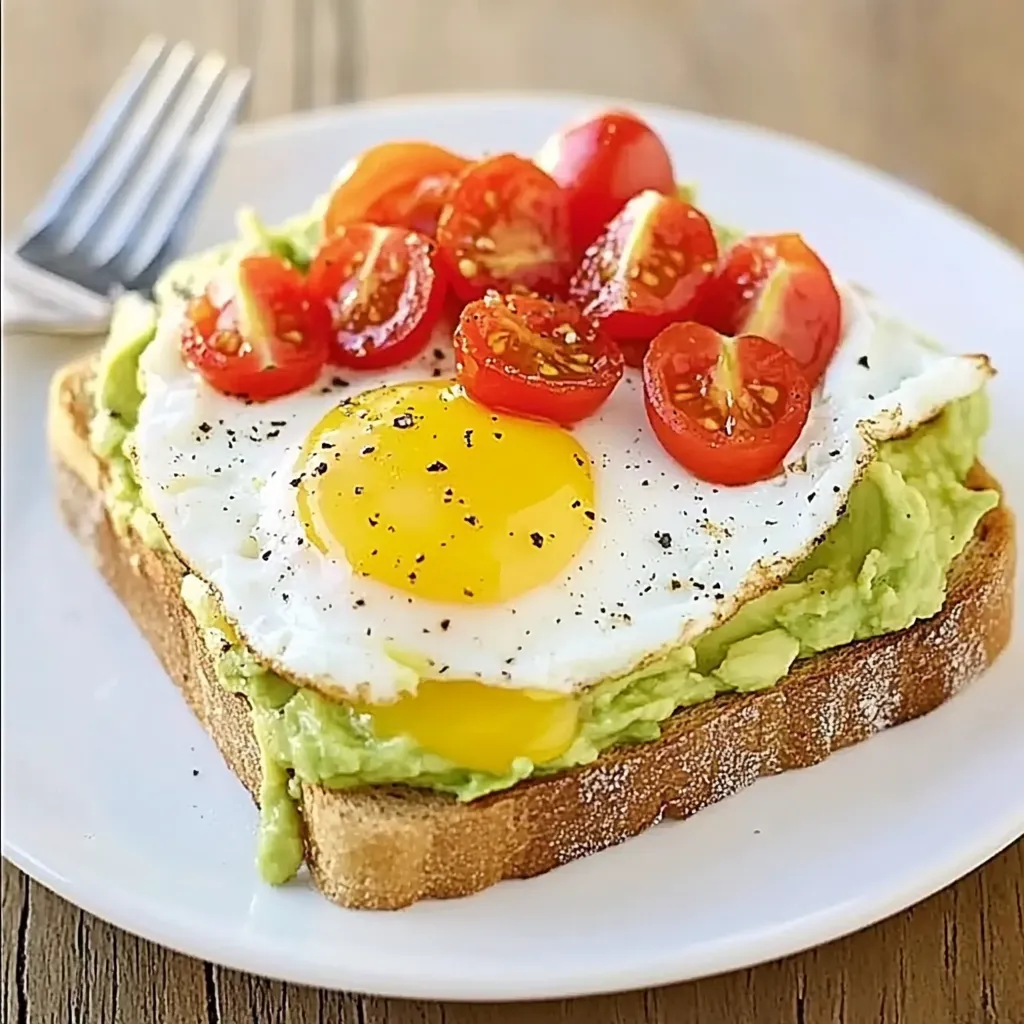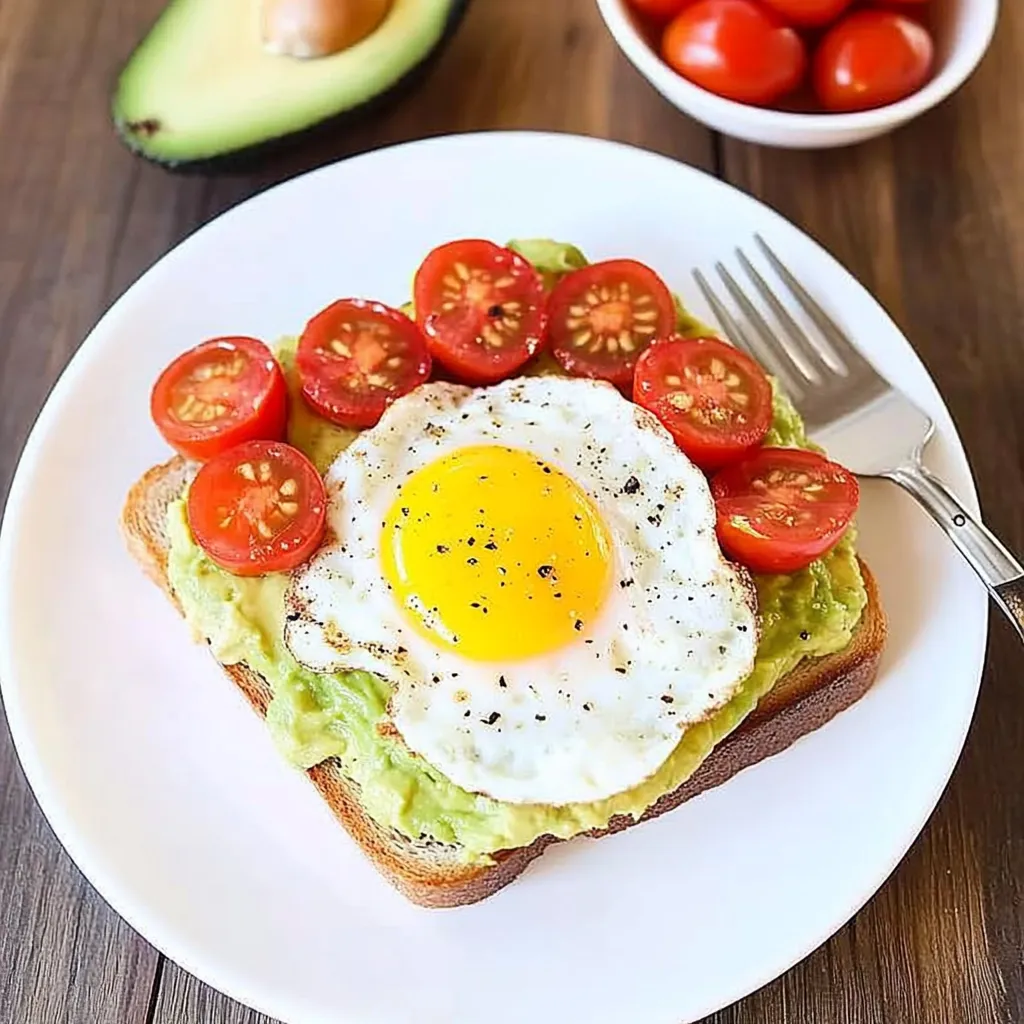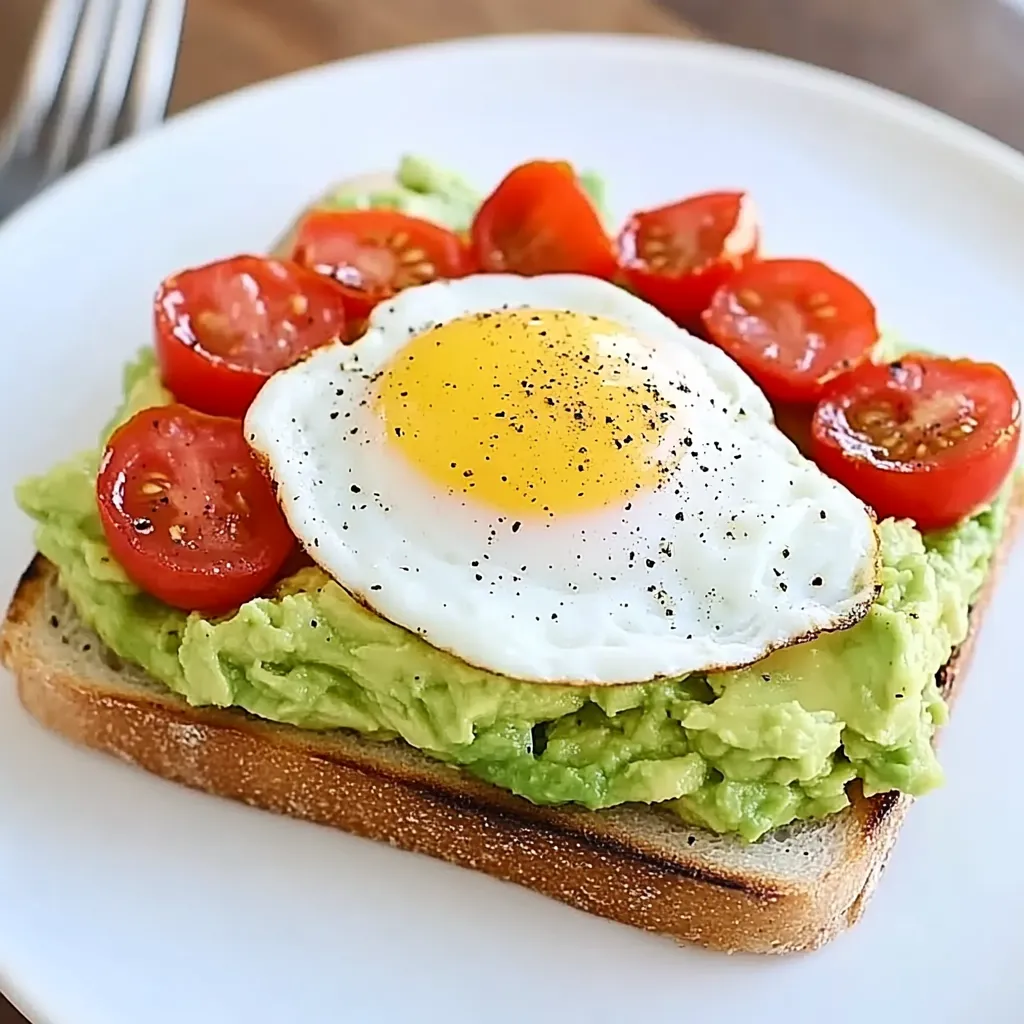 Pin it
Pin it
Layered Breakfast Canvas
This extraordinary toast creation combines multiple flavor dimensions to transform everyday ingredients into something truly magnificent. The magic happens in the careful layering that allows each component to shine while creating a harmonious whole that satisfies both nutritional needs and culinary cravings. I developed this recipe during a particularly abundant avocado and egg season, seeking something beyond basic avocado toast that would still come together quickly.
Morning Masterpiece
My journey with this toast began when our backyard chickens started producing more eggs than we could reasonably use in traditional preparations. What started as a practical solution quickly became my favorite anytime meal. Even my husband, typically skeptical of "breakfast foods" served later in the day, requests these toasts for dinner at least weekly. The bright colors and varying textures make this simple dish feel special enough for weekend brunches yet approachable enough for Tuesday mornings.
Quality Components
- Whole Wheat Bread (2 slices): Creates the sturdy foundation that supports multiple toppings while providing essential fiber and nutrients missing from white alternatives
- Classic Hummus (4 tablespoons): Contributes creamy texture and nutty depth while adding protein and serving as the perfect adhesive layer that prevents toppings from sliding
- Ripe Avocado (1 medium): Delivers that unmistakable buttery richness and healthy fats that transform simple toast into something truly satisfying
- Fresh Eggs (2 large): Provide the crowning protein element with versatile preparation options that can be tailored to individual preference
- Grape Tomatoes (1/2 cup, chopped): Add bright acidity and juicy freshness that cuts through the richness of the other components
- Sea Salt and Black Pepper: Enhance and unite all the flavors, with their proper application at each stage being crucial to the overall experience
 Pin it
Pin it
Simple Artistry
- Egg Excellence:
- Begin with the eggs, as they require the most active cooking attention. For perfectly cooked eggs that complement these toasts, heat a non stick skillet over medium heat with a small amount of olive oil or butter. When the pan is properly heated, crack your eggs directly into the skillet, being careful to maintain yolk integrity if preparing over easy style. For runny yolks, cook until the whites are completely set but the yolk remains bright yellow and liquid, approximately 2 to 3 minutes, then carefully flip and cook for just 15 to 30 seconds on the second side before removing. For fully cooked yolks, follow the same process but allow to cook 1 to 2 minutes after flipping. The advantage of cooking eggs separately rather than baking them atop the toast is the precise control over doneness and the ability to season them individually before assembly.
- Toast Foundation:
- While the eggs cook, prepare your bread by toasting to golden brown perfection with a texture that remains slightly soft in the center while developing crisp edges. This textural contrast provides the ideal base that won't crumble under toppings yet isn't so hard it becomes difficult to eat. Different bread varieties require different toasting times, so watch carefully rather than relying solely on toaster settings. Once toasted, place on serving plates and immediately begin assembly while still warm. The residual heat helps the hummus spread more easily while slightly warming the other toppings for a more cohesive final result.
- Thoughtful Assembly:
- Spread each toast with 2 tablespoons of hummus, creating an even layer that reaches nearly to the edges. This hummus layer serves as both flavor component and practical adhesive that helps other toppings remain in place. Next, in a small bowl, mash the avocado with a fork until it reaches your preferred consistency, whether completely smooth or with small chunks remaining for textural interest. Season the mashed avocado with a pinch of sea salt and freshly ground black pepper, which enhances its natural flavor significantly. Divide the seasoned avocado between the toasts, spreading it evenly over the hummus layer. This deliberate layering order prevents the moist avocado from making the toast soggy by placing the protective hummus barrier between them.
- Final Composition:
- Carefully place one cooked egg atop each toast, positioning it to ensure every bite will include some egg. Scatter the chopped grape tomatoes evenly over and around the eggs, allowing some to fall alongside the toast on the plate for visual appeal. Finish with a final light sprinkle of sea salt and freshly cracked black pepper over the entire creation, which unifies the components while providing seasoning for the tomatoes. For those who enjoy fresh herbs, a scatter of chopped chives, parsley, or cilantro adds color and flavor complexity. Serve immediately while the toast maintains its contrast of warm and cool elements, with the residual heat from the egg slightly warming the avocado beneath it.
I particularly treasure the memories these toasts evoke of our early days with backyard chickens. The first morning I collected still warm eggs and transformed them into this meal just minutes later was a revelation in freshness that commercial eggs simply cannot match. My children have grown up helping to gather eggs, mash avocados, and assemble their own toast creations, learning cooking fundamentals through this simple preparation. Even my father, who claimed for decades to dislike avocados, became a convert after trying this particular combination of flavors. There's something uniquely satisfying about creating something so nourishing from ingredients with such direct connections to your own garden and animals.
Meal Versatility
This adaptable creation welcomes serving at virtually any time of day and for numerous occasions. For rushed weekday mornings, prepare all components assembly line style for the entire family, allowing each person to customize their egg doneness preference. Weekend brunch gatherings call for a toast bar approach, with various bread options, multiple hummus flavors, and additional toppings like microgreens, crumbled feta, or smoked salmon alongside the standard ingredients. As a light dinner, pair with a simple green salad dressed with lemon vinaigrette for a complete meal that satisfies without overwhelming. For entertaining, create miniature versions using small bread rounds or bagel halves as elegant appetizers that combine familiar flavors in a sophisticated presentation. During hot summer months, consider using toasted sourdough and serving with cold sliced seasonal fruits for a refreshing no cook dinner option.
Creative Extensions
This foundation recipe welcomes countless variations to suit different tastes or available ingredients. For additional protein and flavor complexity, add crispy bacon or prosciutto pieces alongside the egg. Vegetable enthusiasts might incorporate thinly sliced radishes, cucumber, or microgreens for added nutrition and textural contrast. Those seeking spice could add a drizzle of sriracha, a sprinkle of red pepper flakes, or sliced jalapeños before the final seasoning. Mediterranean variations work beautifully with the addition of crumbled feta, chopped olives, and a sprinkle of za'atar seasoning. For a Mexican inspired version, substitute guacamole for plain mashed avocado and top with pickled red onions and cilantro. Bread options beyond whole wheat might include sourdough, seeded multigrain, or even English muffins, each bringing different textural and flavor contributions to the final result.
 Pin it
Pin it
Preparation Pointers
While this dish reaches its peak when freshly assembled, certain components can be prepared in advance for streamlined assembly. Hard boiled eggs can be cooked up to three days ahead and refrigerated in their shells, then peeled and sliced just before serving. Avocados are best mashed immediately before use to prevent browning, though adding a squeeze of lemon juice to mashed avocado can extend its appearance for approximately one hour if needed for entertaining. Chopped tomatoes can be prepared several hours ahead and stored covered in the refrigerator. For meal prep scenarios, consider keeping components separate and assembling just before eating, perhaps packing toasted bread in one container and toppings in another to prevent sogginess. The beauty of this dish lies partly in its freshness, so minimal advance preparation typically yields the most satisfying results.
After preparing these toasts countless times across seasons and circumstances, I've come to appreciate them not just as a practical meal solution but as a perfect example of how simple, quality ingredients require minimal manipulation to create something truly satisfying. What begins as basic components transforms through thoughtful layering into a dish that nourishes body and spirit with vibrant colors, contrasting textures, and balanced nutrition. While restaurant avocado toasts often disappoint with skimpy toppings or overwhelming seasoning, this homemade version delivers perfectly balanced bites every time, proving that some of the most memorable food experiences emerge from our own kitchens rather than elaborate culinary establishments.
Frequently Asked Questions
- → Can I make these Hummus, Avocado, and Egg Toasts ahead of time?
- These toasts are best enjoyed fresh as the ingredients can change texture over time. However, you can prep components in advance to speed up assembly. Cook eggs ahead and refrigerate for up to 2 days, then gently reheat. Smash avocado just before serving to prevent browning. Store hummus separately. When ready to eat, toast the bread and assemble all components for the freshest experience. For meal prep, consider keeping all components separate and assembling just before eating.
- → What type of bread works best for these toasts?
- While the recipe suggests whole wheat bread for its nutty flavor and nutritional benefits, many bread varieties work wonderfully. Sourdough offers tangy notes and a sturdy texture, seeded bread adds interesting texture and nutrition, and rye pairs particularly well with the eggs and avocado. For a heartier meal, try thick-cut artisan bread. If you're gluten-sensitive, a high-quality gluten-free bread will work too. Whatever bread you choose, toasting it is essential to provide a sturdy base for the toppings.
- → What can I substitute for hummus if I don't have any?
- If you don't have hummus available, several alternatives can provide a similar creamy base. Try greek yogurt mixed with a little olive oil, salt, and lemon juice for a tangy option. Cottage cheese blended until smooth works well too. For a different flavor profile, try soft goat cheese or cream cheese. Refried beans (well-seasoned) can provide a similar texture with Latin American flair. Even a layer of mayo mixed with herbs can work in a pinch, though it will offer a different nutritional profile than protein-rich hummus.
- → How can I make this recipe vegan?
- To make this recipe vegan, simply omit the egg and consider one of these protein-rich replacements: crumbled firm tofu seasoned with turmeric and black salt (kala namak) for an eggy flavor, sliced seasoned tempeh for heartiness, roasted chickpeas for crunch and protein, or a sprinkle of nutritional yeast for a savory boost. You could also add extra protein by using a bean-based spread like white bean hummus under the avocado. Top with additional vegetables like roasted red peppers or sautéed mushrooms for more substance.
- → What can I add to these toasts to make them more filling?
- To make these toasts more substantial, try adding: crispy bacon or prosciutto for savory protein, smoked salmon for an omega-rich boost, a sprinkle of toasted seeds like pumpkin, sunflower, or hemp for texture and nutrition, a drizzle of pesto or chimichurri for flavor intensity, sliced radishes or cucumber for freshness and crunch, pickled red onions for tang, crumbled feta or goat cheese for creamy richness, or a handful of microgreens or arugula for volume and nutrients. You can also simply use a thicker slice of artisan bread as your base.
- → How do I prevent the avocado from browning if I want to save half for later?
- To prevent unused avocado from browning: Keep the pit in the unused half, as it helps slow oxidation. Brush the exposed flesh with lemon or lime juice, as the citric acid acts as a natural preservative. Store it flesh-side down on a plate to minimize air exposure. Wrap tightly with plastic wrap, pressing it directly against the flesh to eliminate air pockets. For longer storage, place in an airtight container with a piece of onion (without touching), as the sulfur compounds prevent browning. Refrigerate immediately after these steps. Use the remaining avocado within 24 hours for best quality.
